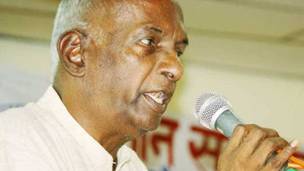 ALLAHABAD: Ganga is considered as the cradle of great Indian civilization and the holy river cares for all irrespective of caste, creed, race, religion, colour and region, opined social and political activist and thinker KN Govindacharya. He was visiting an exhibition on Ganga at the Magh mela area, on Monday.
ALLAHABAD: Ganga is considered as the cradle of great Indian civilization and the holy river cares for all irrespective of caste, creed, race, religion, colour and region, opined social and political activist and thinker KN Govindacharya. He was visiting an exhibition on Ganga at the Magh mela area, on Monday.
Govindacharya further said that water of river Ganga plays a vital role in hindu ceremonies, in rituals of birth and initiation of marriage and death. “We can’t imagine Hinduism without Ganga because this river is the essence of Hinduism and as such the pollution of this river means the death of our glorious culture and precious civilization”, he said. He added that Ganga is an apt example of our rich heritage which stands like a bedrock to support and sustain our present as well as our future.
While witnessing the exhibits on display, Govindacharya said that exhibitions, such as this, play a significant role to awaken people’s consciousness and their duties to save rivers of India. It is biggest platform for mass awareness and is a great effort of a great person who spread mythological social, economic, cultural and scientific significance of Ganga to people and encourage for their active participation to save such a holy river that nourish them.
The convener of the Ganga exhibition, Prof DN Shukla of the department of Botany, Allahabad University, welcomed Govindacharya and said that the exhibition has been held since last 36 years during the Magh Mela, Ardh and Maha Kumbha at Allahabad from with objectives to create large scale awareness in the stark reality of environmental pollution in general and Ganga pollution in particular.
He further said the the Ganga ecosystem and its food web must view holistically with integrated and watershed perspectives. It is of great importance in northern India because its water is used for human and cattle consumption, power generation, fish production, and irrigation and for pilgrimage. It is considered as ‘River of Life’. So, pollution of Ganga affects more than 400 million people as well as animals and all the organisms that are directly or indirectly dependent upon Ganga water.





